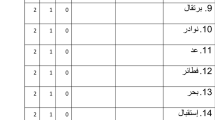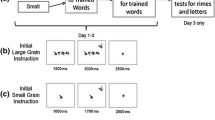Abstract
The study investigated L1 orthographic impact on cognitive processing involved in L2 reading. In a cross-linguistic experiment with four orthographically diverse groups (Arabic, English, Japanese, and Spanish), the effects of two types of phonological encoding interference (phonological similarity and unpronounceability) on short-term memory recall performance in English were compared. Data demonstrate that (a) STM recall performance of all four groups was seriously impaired when phonological encoding interference was present, (b) the two types of interference had differential effects on STM performance between phonographic (Arabic, English, and Spanish) and morphographic (Japanese) readers, and (c) phonological coding strategies used in L1 and L2 are consistent. These results seem to indicate, first, that a phonological code is dominantly used in the STM encoding process regardless of the language background: second, that different phonological coding strategies are used among subjects with contrasting orthographic backgrounds; and, third, that strategies used in L1 processing are transferred to L2 processing. Hence, the findings of the study suggest that there is a strong relationship between orthography and cognition.
Similar content being viewed by others
References
Baddeley, A.D. (1966). Short term memory for word sequences as a function of acoustic, semantic, and formal similarity.Quarterly Journal of Experimental Psychology, 18, 362–365.
Baddeley, A. D. (1978). The trouble with levels: A reexamination of Craik and Lockhart's framework or memory research.Psychological Review, 85, 139–152.
Baron, J. (1973). Phonemic stage not necessary for reading.Quarterly Journal of Experimental Psychology, 25, 241–246.
Baron, J. & Strawson, C. (1976). Use of orthographic and word-specific knowledge in reading words aloud.Journal of Experimental Psychology: Human Perception and Performance, 2, 386–393.
Besner, D., & Hildebrandt, N. (1987). Orthographic and phonological codes in the oral reading of Japanese Kana.Journal of Experimental Psychology: Learing, Memory, and Cognition, 13, 335–343.
Bradly, L., & Bryant, P.E. (1983). Categorizing sounds and learning to read—A causal connection.Nature, 301, 419–421.
Chi, M. T. H. (1976). Short-term memory limitations in children: Capacity or processing deficts?Memory and Cognition, 4, 559–580.
Cimbalo, R. S., & Laughery, K. B. (1967). Short term memory: Effects of auditory and visual similarity.Psychonomic Science, 8, 57–58.
Coltheart, M. (1978). Lexical access in simple reading task. In G. Underwood (Ed.),Strategies of information processing. London: Academic Press.
Coltheart, M. (1984). Writing systems and reading disorders. In L. Henderson (Ed.),Orthographies and reading: Perspectives from cognitive psychology, neuropsychology, and linguistics, Hillsdale, NJ: Erlbaum.
Conrad, R. (1964). Acoustic confusion in immediate memory.Britisch Journal of Psychology, 55, 75–84.
Conrad, R., & Hull, A. J. (1964). Information, acoustic confusion and memory span.British Journal of Psychology, 55, 429–432.
Crowder, R. C. (1978). Language and memory. In J. F. Kavanagh & W. Strange (Eds.),Speech and language in the laboratory, school, and clinic. Cambridge, MA: M. I. T. Press.
Cunningham, P. M., & Cunningham, J. W. (1978). Investigating the “print to meaning” hypothesis. In P. D. Pearson, & J. Hansen (Eds.),Reading: Disciplined inquiry in process and practice (27th Yearbook of the National Reading Conference). Clemson, SC: National Reading Conference.
Daneman, M., & Carpenter, P. A. (1980). Individual differences in working memory and reading.Journal of Verbal Learning and Verbal Behavior, 19, 450–466.
Eriksen, C. W., Pollack, M. D. & Montague, W. E. (1970). Implicit speech: Mechanisms in perceptual cooding?Journal of Experimental Psychology, 84, 502–507.
Gelb, I. J. (1963).A study of writing. Chicago: University of Chicago Press.
Gleitman, L. R. (1985). Orthographic resources affect reading acquisition—If they are used.Remedial and Special Education, 6, 24–36.
Gleitman, L. R., & Rozin, P. (1977). The structure and acquisition of reading I: Relation between orthographies and the structure of language. In A. S. Reber & D. L. Scarborough (Eds.),Toward a psychology of reading: The processings of the CUNY conference. Hillsdale, NJ: Erlbaum.
Glushko, R. J. (1979). The organization and activation of orthographic knowledge in reading aloud.Journal of Experimental Psychology: Human Perception and Performance.5, 674–691.
Goody, J. (1968). Introduction. In J. Goody (Ed.),Literacy in traditional societies. Cambridge, Cambridge University Press.
Goody, J., & Watt, I. (1963). The consequence of literacy.Comparative Studies in Society and History, 5, 303–345.
Green, D. W., & Shallice, T. (1976). Direct visual access in reading for meaning.Memory and Cognition, 4, 753–758.
Hanson, V. L. (1982). Short-term recall by deaf signers of American sign language: Implications of encoding strategy for order recall.Journal of Experimental Psychology: Learning, Memory, and Cognition, 8, 572–583.
Healy, A. F. (1975). Coding of temporal-spatial patterns in short-term memory.Journal of Verbal Learning and Verbal Behavior, 14, 481–495.
Henderson, L. (1982).Orthography and word recognition in reading. London: Academic Press.
Henderson, L. (1985). Issues in the modeling of pronunciation assembly in normal reading. In K. E. Patterson, J. C. Marshall, & M. Coltheart (Eds.),Surface dyslexia. Hillsdale, NJ: Erlbaum.
Japanese National Research Institute (1964).The development of language ability in elementary school children. Tokyo: Sohuei Shuppan.
Just, M. A., & Carpenter, P. A. (1980). A theory of reading: From eye fixation to comprehension.Psychological Review, 87, 329–354.
Just, M. A., & Carpenter, P. A. (1987).The psychology of reading and language comprehension. Boston: Allyn and Bacon.
Kaiho, H., & Nomura, Y. (1983).Kanji johoshori no shinrigaku [The psychology of Kanji processing]. Tokyo: Kyoiku Shuppan.
Kintch, W., & van Dijk, T. A. (1978). Toward a model of text comprehension.Psychological Review, 85, 363–394.
Klapp, S. T. (1971). Implicit speech inferred from response latencies in same-different decisions,Journal of Experimental Psychology, 91, 262–267.
Kleiman, G. M. (1975). Speech recoding in reading.Journal of Verbal Learning and Verbal Behavior, 14, 323–340.
Koda, K. (1987). Cognitive strategy transfer in second language reading. In J. Devine, P. L. Carrell, & D. E. Eskey (Eds.),Research in reading in English as a second language. Washington, DC: TESOL.
Levy, B. A. (1971). Role of articulation in auditory and visual short-term memory.Journal of Verbal Learning and Verbal Behavior, 10, 123–132.
Levy, B. A. (1975). Vocalization and suppression effects in sentence memory.Journal of Verbal Learning and Verbal Behavior, 14, 304–314.
Levy, B. A. (1977). Reading: Speech and meaning processes.Journal of Verbal Learning and Verbal Behavior, 16, 623–628.
Liberman, I. Y., Mann, V. A., Shankweiler, D., & Werfelman, M. (1982). Children's memory for recurring linguistic and nonlinguistic material in relation to reading ability.Cortex, 18, 367–375.
Liberman, I. Y., & Shankweiler, D. (1985). Phonology and the problems of learning to read and write.Remedial and Special Education, 6, 8–17.
Mann, V. A. (1985). A cross-linguistic perspective on the relation between temporary memory skills and early reading ability.Remedial and Special Education, 6, 37–42.
McCutchen, D., & Perfetti, C. A. (1982). The visual tongue-twister effect: Phonological activation in silent reading.Journal of Verbal Learning and Verbal Behavior, 21, 672–687.
Meyer, D. E., & Ruddy, M. G. (1973).Lexical-memory retrieval based on graphemic and phonemic representation of printed words. Paper presented at the meeting of the Psychonomic Society, St. Louis.
Mou, L. C., & Anderson, N. S. (1981). Graphemic and phonemic codings of Chinese characters in short-term retention.Bulletin of the Psychonomic Society, 17, 255–258.
Murry, D. J. (1965). Vocalization-at-presentation and immediate recall with varying presentation rates.Quarterly Journal of Experimental Psychology, 17, 47–56.
Navon, D., & Shimron, J. (1984). Reading Hebrew: How necessary is the graphemic representation of vowels? In L. Henderson (Ed.),Orthographies and reading: Perspectives from cognitive psychology, neuropsychology, and linguistics. Hillsdale, NJ: Erlbaum.
Olson, D. R. (1975). Review ofToward a literacy society (J. B. Carroll & J. Chall, eds.).Proceedings of the National Academy of Education, 2, 109–178.
Olson, D. R. (1977). From utterance to text: The bias of language in speech and writing.Harvard Educational Review, 47, 257–281.
Paradis, M., Hagiwara, H., & Hildebrandt, N. (1985).Neurolinguistic aspects of the Japanese writing system. New York: Academic Press.
Patterson, K. E., & Morton, J. (1985). From orthography to phonology: An attempt at an old interpretation. In K. E. Patterson, J. C. Marshall, & M. Coltheart (Eds.),Surface dyslexia, Hillsdale, NJ: Erlbaum.
Perfetti, C. A., & Lesgold, A. M. (1977). Discourse comprehension and source of individual differences. In M. A. Just & P. A. Carpenter (Eds.),Cognitive processes in comprehension. Hillsdale, NJ: Erlbaum.
Perfetti, C. A., & Lesgold, A. M. (1979). Coding and comprehension in skilled reading and implications for reading instruction. In L. B. Resnick & P. Weaver (Eds.),Theory and practice of early reading. Hillsdale, NJ: Erlbaum.
Perfetti, C. A., & McCutchen, D. (1982). Speech process in reading. In N. Lass (Ed.),Advances in speech and language (Vol. 7). New York: Academic Press.
Rosson, M. B. (1985). The interaction of pronunciation rules and lexical representation in reading aloud.Memory and Cognition, 13, 90–99.
Rubenstein, H., Lewis, S. S., & Rubenstein M. A. (1971). Evidence for phonemic recording in visual word recognition.Journal of Verbal Learning and Verbal Behavior, 10, 647–657.
Sasanuma, S. (1984). Can surface dyslexia occur in Japanese? In L. Henderson (Ed.),Orthographies and reading: Perspectives from cognitive psychology, neuropsychology, and linguistics. Hillsdale, NJ: Erlbaum.
Scribner, S., & Cole, M. (1981).The psychology or literacy. Cambridge, MA: Harvard University Press.
Seidenberg, M. S. (1985). The time course of phonological code activation in two writing systems.Cognition, 19, 1–30.
Seidenberg, M. S., Waters, G. D., Barnes, M. A., & Tanenhaus, M. K. (1984). When does irregular spelling or pronunciation influence word recognition?Journal of Verbal Learning and Verbal Behavior, 23, 384–404.
Shirakawa, S. (1978).Kanji hyakuwa [Hundred stories of Kanji]. Tokyo: Chukoshinsho.
Slowiaczek, M. L., & Clifton, C., Jr. (1980). Subvocalization and reading for meaning.Journal of Verbal Learning and Verbal Behavior, 19, 573–582.
Taft, M. (1982). An alternative to grapheme-phoneme conversion rules?Memory and Cognition, 10, 465–474.
Theios, J., & Muise, J. G. (1976). The word identification process in reading. In N. J. Castellan, Jr., & D. Piosoni (Eds.),Cognitive theory (Vol. 2). Potomac, MD: Erlbaum.
Turvey, M. T., Feldman, L. B., & Lukatela, G. (1984). The Serbo-Croatian orthography constrains the reader to a phonologically analytic strategy. In L. Henderson (Ed.),Orthographies and reading: Perspectives from cognitive psychology, neuropsychology, and tinguistics. Hillsdale, NJ: Erlbaum.
Tzeng, O. J. L., Hung, D. L., & Wang, W. S.-Y. (1977). Speech recoding in reading Chinese characters.Journal of Experimental Psychology: Human Learning and Memory, 3, 621–630.
Tzeng, O. J. L., & Wang, W. S.-Y. (1983). The first two R's: The way different languages reduce speech to script affects how visual information is processed in the brain.American Scientist, 71, 238–243.
Wickelgren, W. A. (1965). Acoustic similarity and retroactive interference in short-term memory.Journal of Verbal Learning and Verbal Behavior, 70, 102–108.
Yik, W. F. (1978). The effect of visual and acoustic similarity on short-term memory for Chinese words.Quarterly Journal of Experimental Psychology, 30, 487–494.
Yu, B., Zhang, W., Jing, Q., Peng, R., Zhang, G., & Simon, H. A. (1985). STM capacity for Chinese and English language materials.Memory and Cognition, 13, 202–207.
Zhang, G., & Simon, H. A. (1985). STM capacity for Chinese words and idioms: Chunking and acoustical loop hypotheses.Memory and Cognition, 13, 193–201.
Author information
Authors and Affiliations
Rights and permissions
About this article
Cite this article
Koda, K. Effects of L1 orthographic representation on L2 phonological coding strategies. J Psycholinguist Res 18, 201–222 (1989). https://doi.org/10.1007/BF01067782
Accepted:
Issue Date:
DOI: https://doi.org/10.1007/BF01067782




